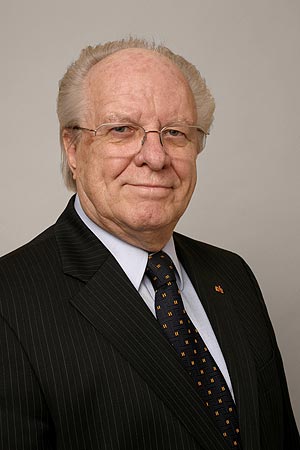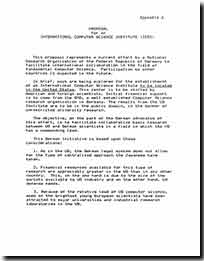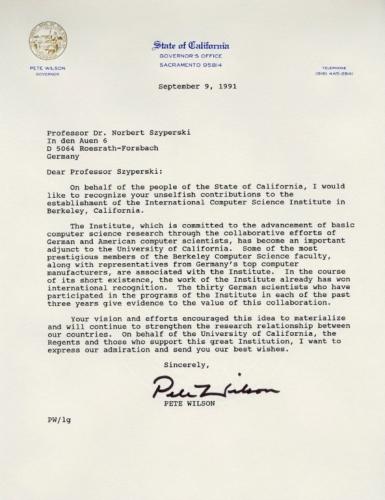Featured Fellow: Norbert Szyperski
Back to ICSI Gazette, Spring 2014

Norbert Szyperski has never been an ICSI employee, but in many ways, he is our most important alumnus. It was through his conversations with Ron Kay, a former IBM Research manager, that the idea for an international computer science institute crystalized; it was his lobbying that convinced the German government and German companies to fund the institute; and it was his vision that was realized more than twenty-five years ago when ICSI was inaugurated in October of 1988. But ICSI is certainly not Szyperski’s first achievement, nor his last.
Eisenhower Fellowship
Szyperski has had a career-long interest in business administration, applications of information and communications technology, and the question of how to implement new ICT technologies into businesses and public organizations. His interest was sparked in the 1950s, a time when, he says, “the first really interesting machines came into the market in the fields of science, engineering, and business.” He was a student at the Freie Univerität Berlin, where he fell in love and began working for his future father-in-law’s business, selling office machines.
He received his undergraduate and doctoral degrees and, in 1962, was elected as an Eisenhower Fellow. The fellowship program, established in the United States in 1953 to encourage cooperation with other countries, brings mid-career professionals in business, science, and the arts from around the world and provides them with funds and connections to travel the U.S., meet leaders in their fields, and build their leadership skills. Szyperski’s fellowship topic was the social and economic challenge of automation. In his travels around the U.S., which he called a “tremendous” experience, he met the governors of North Carolina and California and the presidents of universities and major companies, including IBM. Ron Kay said the program “was very successful because many participants became leaders, much like ICSI postdocs.”
Indeed, Szyperski is proof of the success of the Eisenhower Fellowship, which has been awarded to more than 2,000 people over the course of its 60 years. His son Clemens, who was born in the U.S. during the fellowship, is now a principal development manager at the Data Platform Group of Microsoft Research in Redmond, Washington; another son, Thomas, is a distinguished professor at State University of New York, Buffalo, where he is the director of the High-Field Magnetic Resonance Facility. Last year, Szyperski was one of 60 alumni whose stories the fellowship program highlighted to mark its 60th anniversary. “You see, we gave something back,” Szyperski says.
University of Cologne
After his fellowship, Szyperski spent a year as a visiting professor at the University of Florida Gainesville, then returned to Germany. He received his Privatdozent degree, in preparation for candidacy for a full professorship, from the Freie Universität Berlin and in 1968 began teaching at the University of Cologne. There, he and Professor Erwin Grochla founded an institute that supported research on information technology in business, the Betriebswirtschaftliches Institut für Organisation und Automation (BIFOA). “We created research by development,” said Szyperski. “We went into companies to create new things to study. If you’re just doing empirical research, you’re in the past, not going into the future.” Szyperski has continued to be affiliated with the university throughout his life, becoming an adjunct professor in the mid-1980s and returning to teach for seven semesters in the mid-1990s. Now an emeritus, he remains an honorary professor of the university.
Ron Kay, who met Szyperski while he was the director of BIFOA, said, “Many students of his became leading figures in business and academia. He introduced the role of computing to business schools.”
Ron Kay
As the head of BIFOA, Szyperski was often invited to travel throughout Europe to moderate conferences and give talks. He was sometimes invited to IBM’s offices in Europe, the largest of which was in Germany. At one of these meetings, he met Ron Kay, a senior manager of research planning at IBM based in the Bay Area. Kay’s talk at the meeting was about the future direction of research, and Szyperski’s talk was about the need to adapt organizations before adopting technologies. They struck up a friendship that has lasted to this day. “We’ve become very close friends,” Kay said.
The friendship led to several professional collaborations: Szyperski invited Kay to spend time at BIFOA and was asked to nominate people to participate in a newly established fellowship program at IBM’s Research Division. It was also out of this friendship that the plan for ICSI came.
GMD
In 1979, the German research minister asked Szyperski to be on the supervisory board of the Gesellschaft für Mathematik und Datenverarbeitung (Society for Mathematics and Information Technology, or GMD), and in 1981 asked him to take over the institute. The GMD, a German research organization, had been founded by applied mathematicians in 1968 and, by the time Szyperski took over, comprised about 1,500 scientists of different disciplines and from different locations. However, when Szyperski took it over, Kay said, “It needed major redirection.”
Szyperski says the institute’s emphasis on theory detracted from applied sciences: “The scientists liked to talk and think about it, but not to do it. Because of the heavy influence of mathematics, computer science was overlooked and engineering was not part of it.” Szyperski decided to change the institute’s focus, putting a heavier emphasis on applied algorithms and software. “I was changing it as a non-specialist,” he said. “It was easy to talk about subjects when you know where they are coming from and what they are trying to do.”
He succeeded in bringing together computer science and engineering in order to build faster computers – for example, a supercomputer, SUPRENUM, that was for a time the fastest computer in the world.
The GMD also gave Szyperski the chance to see how far Germany’s computer science community lagged behind those of other countries. “He came up with the idea that Germany was completely isolated from international computer science,” said Kay, “and he wanted to change that.”
ICSI
In the 1980s, computer science was an emerging field, with little precedent at major universities. Kay says a surplus of scientists in the U.S. was available to forge the new discipline; Germany, which had lost many of its brightest scientists during World War II and the years leading to it, could not count on such a surplus. Kay said that in Germany, “Computer science was uniquely behind in every respect in the early 1980s.”
In 1984, Szyperski, who was still leading the GMD, and Kay, who had retired from IBM, started talking about how to correct this in ways that would benefit not only Germany but the field of computer science itself. From these talks came the idea of an international computer science institute, based in the United States, affiliated with but independent from a major university. “It had to be possible to create an institutional frame that would bridge Germany and the U.S.,” Szyperski said. “You’d have a bridge with two pillars.”
In the U.S., there was a complementary desire for such an institute. U.S. faculty were concerned about academic science’s major dependence upon DARPA funding. DARPA, the research arm of the Department of Defense, provided a huge proportion of computer science funding at the time. Faculty were attracted to the idea of an independent institute that would provide a broader funding base as well as the same intellectual freedom granted by university departments.
Many obstacles stood in the way. Getting German entities to fund such an institute, from which they would be separated by an ocean and a continent, was the next problem. “There was a good understanding that computer science and engineering in the U.S. were developed. It was easy to transfer this idea,” says Szyperski. “It was more difficult to get an understanding that it could not be financed only by public money.” In addition, the German government could not give money to a U.S. institution directly; rather, a public-private partnership had to be established through which German funds could be sent to the U.S.
“The Germans had to trust my story,” Szyperski said. “Like in business, you have a good story and good partners, and it’s up to management.”
Szyperski’s vision and dedication paid off. “He sold the idea of ICSI to them,” Kay said.
To get private German financing, Szyperski said, “I asked the leader of Mannesmann [a German industry group] what Mannesmann could spend. He said 300,000 D-Mark a year.” He took that offer to the CEO of Siemens, then to Daimler. “I asked five industries, and I got a letter of intent for five years,” he said. “Then I went to the minister and asked for the other 50 percent.” Some of the companies said yes immediately, while others said they wanted to talk about it internally. Finally, in 1988, a sponsoring group, the Foerderverein, was formed.
In the meantime, there was work to do stateside. Between December 1984 and February 1985, Kay visited 18 computer science research organizations in the U.S. He distributed a two-page proposal for an international computer science institute that he and Szyperski had written together. From the conversations he had with about 40 people in academia, industry, and government came a set of parameters for the structure of the institute: it should be independent but affiliated with a university or major research organization; it should perform fundamental rather than applied research; and, as Kay puts it, “It would never fly as a German institute of computer science; it would only fly as an international institute.
The political atmosphere of the 1980s played a role in how the institute would operate. Kay says that when he pitched the idea of the institute to officials at the Office of Science and Technology Policy, which advises the White House, they responded positively but “made it clear that this could not affect U.S. interests.” UC Berkeley, which was eventually chosen as the site, also wanted reassurance that such an institute would not jeopardize either its reputation for world-class research or its ability to receive grants from U.S. agencies like DARPA.
To assuage these fears, Kay and Szyperski emphasized that the institute would focus on non-proprietary, basic research. This aligned with the interests of professors who wanted to do unrestricted research. During his travels to the U.S., Szyperski also had to assure universities and government officials that “this was not a way of pirating information from the U.S.,” Kay says, but rather a way to get young people to benefit from the country’s intellectual environment. Kay says that “the guiding word was unrestricted research” that would be published just as university research was published. In addition, UC Berkeley was to be represented on the board of trustees to guide research decisions.
In March 1985, Kay and Szyperski submitted to the GMD a full proposal that, in addition to laying out the vision for the institute, also evaluated seven U.S. institutions with which it could be affiliated. Of these, five had faculty with sufficient interest and had, by the end of 1985, submitted proposals for ICSI.
In early 1986, the GMD board of directors visited the candidate universities and, in March, announced that Berkeley had been selected. UC Berkeley was chosen partly because other universities already had computer science research centers. “Berkeley was unique in not having that,” Kay said. Also important: the computer science faculty and administration strongly supported the institute, and Professor Michael Rabin of Harvard and Jerusalem Universities – one of the earliest winners of the Turing Award – expressed interest in sitting on the board, especially if UC Berkeley was chosen.
In addition to Rabin, Professor Gerhard Goos sat on the first board. Goos had recently helped established a computer science research institute at the University of Karlsruhe and was essential to solidifying German support of ICSI. He was joined by Professor Domenico Ferrari, the chairman of UC Berkeley’s Computer Science Division; UC Berkeley Provost Joseph Cerny; Professor Richard Karp, who would lead ICSI’s Theory Group (later renamed Algorithms); several other members of the UC Berkeley faculty; and Norbert Szyperski.
Mannesmann and InterScience
In 1986, Szyperski left the GMD – in far better shape than when he took it over – to lead the board of directors at Mannesmann Kienzle GmbH. Mannesmann, its parent corporation, is an industry group with companies in several fields; Mannesmann Kienzle, which with 14,000 employees is one of its largest, focuses on data processing with special applications to automobiles. At Kienzle, Ron Kay says, “he got them into the communications business.” Szyperski worked with Peter Mihatsch to develop the first private competitor to the public telecommunications system, Mannesmann Mobilfunk, which was, he said, “a tremendous business success. We had the chance to create a new business.”
Mannesmann Mobilfunk was succeeding and ICSI was welcoming its first international visitors. Ron Kay says, “Being the restless individual he is, he went back to what he liked to do, which is startups.” Throughout the 1980s, Szyperski had often been asked to provide consulting services by companies, cities, and communities. “Some prefer to get a bill from an organization,” he said – so he founded a small consulting firm, InterScience, in 1992. InterScience is now a network that spans three generations, comprises senior and junior partners, and brings together projects in science and business.
Under InterScience’s auspices, Szyperski established the Sylter Runde a decade ago. Five times a year, experts in different fields and different age groups gather on the island of Sylt, in northern Germany, to discuss specific topics and devise solutions; out of each meeting comes a white paper. “We create out of these discussions institutions, foundations, growing companies,” he said. “The idea is not be like these talk shows, where we talk but now the time is up and we have to go.” He said one important aspect of the meetings is that participants are spread out across three generations: early adulthood, middle age, and over 60. “The main problems around the world are primarily discussed by old men and old women,” he said, “and the people who have to live with their decisions are the young people.”
In late 2013, for example, the Sylter Runde topic was cultural entrepreneurship: how to employ entrepreneurship not only in business, but also in art. “We [Germans] have a tradition that these activities are publicly funded,” he said. “But the funds get scarcer.” For example, he points out, in Germany operas receive 90 to 95 percent of their funding from public sources; by contrast, the Metropolitan Opera House in New York receives nearly all its funding from ticket sales and other private sources.
Changing Antiquated Attitudes
The Sylter Runde is just the latest example of a lifetime spent influencing the direction of entrepreneurship in Germany. “He has had enormous influence changing antiquated attitudes,” Kay said. In the U.S., for example, a failed start-up can sometimes be a point of pride on a résumé because the experience provides an opportunity to examine what went wrong. In the business climate of Germany in the 1980s, failures were badges of shame. “This required the re-education of an entire society,” Kay said. “There’s nobody more effective in doing that than Norbert Szyperski.”
ICSI was part of Szyperski’s intellectual influence. Its earliest visitors include Wolfgang Wahlster, now the CEO of DFKI, the German Research Center for Artificial Intelligence, the leading German research institute for software technology; Oliver Günther, now the president of the University of Potsdam, Germany; and Hervé Bourlard, now the director of the Idiap Research Institute in Switzerland. All three continue to play a vital role in European support of ICSI.
“You don’t always have to do the same thing – you can change.”- Norbert Szyperski |
Kay says that one reason German computer science lagged in the 1980s was a top-down approach to academic activity – a “the professor’s way or the highway” attitude. In the U.S., arguing with a professor is looked upon much more favorably and is even expected. This different way of doing academic research is “one of the most transformative ideas the Germans took back from ICSI,” Kay said.
Since ICSI’s founding, “German computer science has come up to par. They have come up to par in every way. The flow [of information exchange between Germany and ICSI] is as much one way as the other,” Kay said, “and that was the intent.”
Szyperski also championed the idea of government support of research centers and active support, public and private, of business ventures. In a profile of Szyperski for its 60th Anniversary, the Eisenhower Foundation wrote, “That today every mayor in Germany can spell ‘incubator’ is thanks in large part to Szyperski.”
Szyperski has coached between 65 and 70 companies and invested in at least ten. He continues to sit on the boards of several of these.
“Szyperski is an exceptional person in that he is receptive to other ideas,” Kay said. “He had the opportunity to see a vast variety of ways of doing things and the intuitive ability to seize upon ideas.”
Szyperski said simply, “You don’t always have to do the same thing – you can change.”
Szyperski’s tireless efforts on behalf of entrepreneurship have garnered for him numerous accolades. In 1991, then-Governor Pete Wilson of California wrote a letter recognizing his “unselfish contributions” to ICSI and his efforts to “strengthen the research relationship between our countries.” In 1984, he was awarded the Bundesverdienstkreuz Erster Klasse, the Officer’s Cross of the Order of Merit of Germany, and twenty years later, he received the Grosse Bundesverdienstkreuz, the Commander’s Cross of the Order of Merit. In the same year, 2004, ICSI presented him and Ron Kay with Distinguished Service Awards for their “seminal role in the creation of ICSI.”
“Szyperski was never paid for what he did for ICSI,” Kay said. “But what the man did was phenomenal.”


